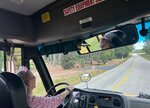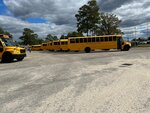

She’s one of about 450 drivers who take the wheel of a school bus every school morning and afternoon around Cumberland County, and on this particular afternoon, Sharron Barnhill has visitors.
Bus drivers are tasked with a great responsibility: ensuring students on board stay safe, on and off the bus — as well getting the 12- or 14-ton vehicles “there and back” on roads where the occasional rushed driver behind them, slowed by frequent stops, will make a frustrated attempt to pass.
And sometimes that happens when a young passenger is disembarking near his or her home.
On this ride, in addition to her 40 student passengers, Barnhill transports Kristi Harden, the executive director of transportation for Cumberland County Schools, and a visiting reporter. Barnhill begins her trip — made this past Tuesday afternoon during School Bus Safety Week, a nationally observed campaign held each October to spotlight rules that keep students from harm’s way — at just before 3 p.m.
Her 63-mile-long, mostly rural route officially launches from a parking lot at Mac Williams Middle School on Clinton Road. Barnhill, who’s been driving buses within the school system 21 years, is, like many drivers, a “dual employee,” doing more than one job for CCS. She serves as the assistant to the bus trainer, helping prepare new drivers for the job.
She began driving a bus during the pandemic. Drivers typically have the same route with the same students each day, and Barnhill — like many of her bus colleagues — builds a strong rapport with her passengers. She knows all 40 of them by name. When they climb on, they enthusiastically greet her as “Ms. Sharron.”
And in addition to this being a week devoted to bus safety, Tuesday happens to be a special day in another regard: it’s Barnhill’s 61st birthday. So in addition to extending birthday wishes, students embarking for a ride home also share stories from their days. They also give her a heads-up as to who won’t be on the bus that afternoon because of after-school practices or events or sickness or travel.
They then head to their assigned seats. Students get to pick their seats only once, at the beginning of the year. This system is designed to keep track of students in the case of an accident or evacuation. The seats are changed only if issues such as bullying arise, or if a parent requests a child sit elsewhere because of medical issues.
The loading happens quickly. Just five minutes after the schoolday ends, the students are seated and Barnhill is on the move for the two-hour trip. A scant 10 minutes after departing, she cites an example of bus safety: Barnhill points out that she never pulls up exactly parallel next to other school buses when stopped.
“These children are very tempted to scream at the children in (the other) bus,” she said.
They also like to wave.
The noise and the movement, Barnhill said, are distracting — and worse, students sticking arms (and heads, or the occasional leg) out the window is an easy way for an injury to occur.
Harden, who helps oversee bus transportation for CCS, walks through additional safety features and procedures used on the bus. One that seems counterintuitive is the use of seatbelts. They’re not found on school buses because the seats inside a bus are designed with ample padding all around. And Harden says seat belts can hinder a quick evacuation in case of an emergency — not all riders, particularly the younger ones, would be able to unbuckle themselves quickly or easily in case a quick exit was needed and they were wearing seat belts.
“It kind of mimics an egg crate," Barnhill says about the padded design of the seats.
Safety practices help
According to the National Highway Safety Administration, fewer than 1% of all traffic fatalities involve children on school transportation vehicles such as buses. In 2020, there were six crashes involving school buses in Cumberland County, the N.C. Deartment of Transportation reported; none resulted in injuries. Two students died in 398 bus-involved incidents across the state that year.
When her bus comes to its first stop, Barnhill demonstrates the safety practice of “flagging.” In order to cross the road to get off the bus, students have to wait for Barnhill to wave her hand across the windshield before they cross. It’s an extra precaution in case vehicles in front or behind haven’t stopped yet. Harden notes this is a newer procedure for drivers, only starting in the last five or so years.
After the departing student at the stop made it safely to his house, it was time to put the bus in reverse. Barnhill yells to the back to ask students if she’s OK to proceed before she begins to back up. A choir of “back-up helpers'' responded loudly to Barnhill with, “You’re good!”
Barnhill’s interactions with her students throughout the ride show how well they work together — and how well she knows her riders.
“I'm so thankful for this bus route,” she says.
Following the rules
The relationships she builds are helpful. Barnhill can only recall one time where she had to truly intervene during an instance of bad student behavior. She had to pull over and get between two boys getting ready to fight. The issue was resolved after she put one of the boys in the front of the bus and the other in the very back.
Her passengers are middle-schoolers, and she says they sometimes struggle with following some rules, but are usually easily corrected.
One of the most common rules her riders break is trying to use the trash can at the front of the bus when the vehicle is in motion. Most students have figured out a workable system to dispose of their trash — either by asking the next rider leaving the bus to toss it for them, or by running up to the trash can during a short stop. Barnhill only asks that the students let others get off the bus first before they make a garbage run.
The second most common rule that gets broken?
Standing.
Barnhill and her kids seem to play a verbal game of whack-a-mole throughout the bus ride — every time a student stands up while the bus is in motion, all she has to do is say their name and they pop immediately back down.
The “no standing” rule is also related to safety — and the concern of kids falling or getting injured if the bus has to make a sudden stop.
Barnhill does have one troublemaker, a seventh-grader she lovingly refers to as “Dennis the Menace.” During this ride, as during many others, he keeps trying to stand up, chatting loudly with friends and making jokes. Barnhill knows he's a sweet kid, just a very energetic one.
To this accusation, “Dennis” yells, “No I’m not!” But eventually, he accepts the truth and sheepishly says, “Just because it's true doesn’t mean you have to say it.”
“He’s got a heart of gold, though,” Barnhill says.
Barnhill balances her rules with fun, however, since she knows this is a crucial time in her kids' lives.
“My kids right now, they're making memories, and I don’t want to be ‘that bus driver,’” she said. She wants her kids to remember “Ms. Sharron” fondly, and not as a mean stickler for the rules.
During a conversation with Barnhill about her route, “Dennis” interrupts.
“Ms. Sharron!” he exclaims. “Tell them about the movies!”
It turns out that Barnhill plays movies and TV shows for her students during her morning route. That morning, they watched “Marmaduke.” Barnhill also sometimes buys snacks, like honey buns and oatmeal cream pies, for her kids. She makes sure to keep the honey buns stocked; they’re much more popular among her riders.
Bus drivers get days off, too. Barnhill prepares a guide for her substitute and has even placed reflective tape on certain signs along her route to make them easier to spot. Barnhill has also trained one of her students, Giovanni, to help guide substitute drivers when she’s absent, pointing out where to turn to pick up or drop off the next rider.
“He knows this route like the back of his hand,” Barnhill says of Giovanni.
A stopped bus? Don't pass.
As the route winds down, Barnhill addresses the bigger safety concerns she sees on her routes from other drivers on the road. She says that cars not stopping while her bus is stopped is the most common driving hazard. In North Carolina, all traffic on a two- or four-lane road must stop when a school bus stops, with the exception of a four-lane road with a turning lane or median.
So far, she’s encountered traffic not stopping for her bus four times. On one of those occasions, a car passed her bus — but it did so directly in front of an N.C. state trooper, who promptly pulled the offending car over, presumably with a citation in hand.
In North Carolina, passing a stopped school bus is a Class 1 misdemeanor, with a mandatory minimum $500 fine. It’s also costly in other ways: a 5-point insurance hit. A second offense can mean a one-year suspension of your driver’s license.
Barnhill also explains the dangers of railroad crossings, especially with Amtrak trains. She says trains are faster than most people think, so at each crossing, she commands silence from her students so she can listen for a train before she crosses.
After the route is finished — just over two hours after it began — Barnhill returns with an empty bus back to Mac Williams Middle School. She parks, checks around for stray items — one student left a pencil case — and does her safety checks.
She then heads home to celebrate her birthday. She’ll awaken at 3:45 a.m. to do it all over again.
Contact Char Morrison at cmorrison@cityviewnc.com.